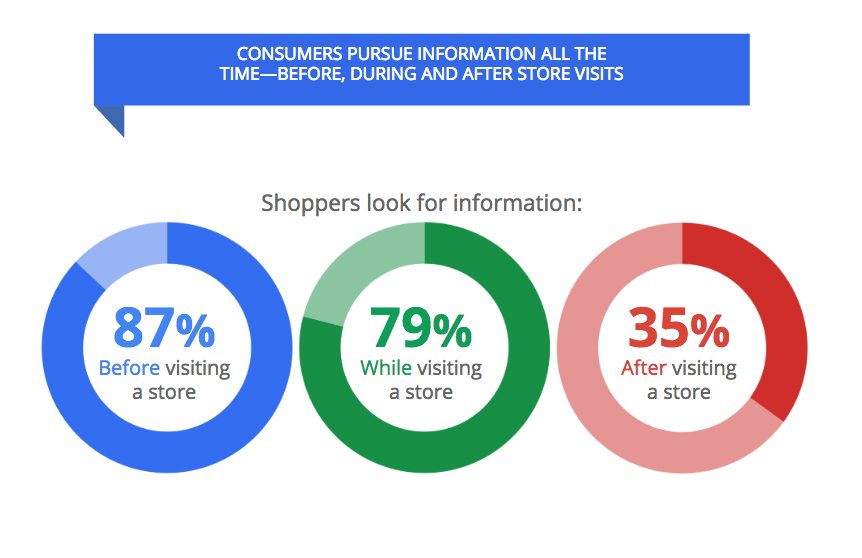Like many, if not most, people, I am not usually an “impulse” shopper, but I am guilty of webrooming. Like me, most internet users spend significant amounts of time researching different brands and models to compare before purchase.

Source: http://think.storage.googleapis.com/docs/digital-impact-on-in-store-shopping_research-studies.pdf
E-commerce magazines and journals talk about this phenomenon often. They talk about “showrooming,” in which a consumer will visit a physical store to gather information about before purchasing online. Often this information comes from another retailer at a reduced price. Another concept that appears to be growing in popularity is “reverse showrooming”. Sometimes called “webrooming,” describes the process of shopper researching products online and buying in-store.
And, the popularity of webrooming is not limited to B2C. According to a study by Forrester, “74% of business buyers conduct more than half of their research online before making an offline purchase.”
A simple Google search will lead you to dozens of articles and blogs laying out strategies to convert these online researchers into purchasers. Whether it’s on or off-line, most articles center around providing the customer with a seamless omnichannel shopping experience. However, too few discuss what should be a glaring implication of these phenomena. One that impacts manufacturers and distributors in addition to retail sellers. Quality and accurate content accessible via multiple channels is essential to influencing a buyer’s purchasing decision.
Webrooming for Lawnmowers
To purchase my next lawnmower, I have multiple paths to purchase. Within 2 miles of my house, there are two large multinational home improvement stores. Also, a handful of department stores that include a garden section. Lastly, there are even a few local nurseries or hardware stores nearly. At any of these, I can browse for more information or make a purchase. Most of these retailers have websites where I can research specs, make price comparisons and even check in-store availability. Also, I have the option of making my purchase online, after doing research either in a physical store or on a brand or retailer’s website.
Buying Criteria
With so many options, how will I narrow down my decision to a brand and model sold from a particular vendor? Like most people, I start with minimum buying criteria:
- I know how often I will use the lawnmower and how large of a lawn I must mow. So, I can effectively gauge the size, durability, and horsepower I require.
- I have a specific budget in mind.
- While I don’t have brand loyalty to any lawnmower manufacturer, some people may. You could even have brand loyalty to a particular retailer or desire to purchase a brand that meets certain criteria, such as “Made in America.”
- I know my threshold for wait time on the product. My willingness to buy or pick it up at a store versus having it shipped directly to my house will also matter.
Many people will have more detailed buying criteria. As the purchase price goes up, most people’s buying criteria become more precise, as well. Not to mention, the more in depth your user will be webrooming. For instance, I don’t care if my new lawnmower is black or red or neon green. Yet, I will have very strong opinions about the color of the next vehicle I purchase.
Research
As I begin to research, I will immediately eliminate any brand and/or model that doesn’t meet all my minimum buying criteria. Then I’ll narrow it down to a handful of options or fewer. Once I have a shortlist, I can compare each on price, availability, average customer reviews, warranty options, and features that are important to me. Finally, after narrowing it down to one or two choices, I might visit a physical store or initiate an online chat. I would do this to gather any additional information about each model that might distinguish one from the other.
My path to purchase is not likely a unique path for buying a lawnmower. Which brand/model am I most likely to purchase and from which retailer? If you answered “The one that best met my buying criteria,” you would only be half correct. I will purchase the lawnmower that best meets my buying criteria based on the information available to me.
Summary
Today’s omnichannel consumer demands good quality content about the products for which we are shopping. We will reward brands and retailers that supply us with the information we need. And, we may even eliminate products that meet our minimum buying criteria only because we never find out that it does. If your website (as a retailer or manufacturer) doesn’t include all the relevant product information we are searching for, your product will not make the final cut.
That’s why you should invest as much in your Information Supply Chain as you do in your physical supply chain. Don’t let webrooming hurt your business. In Part 2 of this blog topic, we will explore the elements of a healthy Information Supply Chain and what you can do to ensure that your customers receive accurate and up-to-date product content on every channel.

